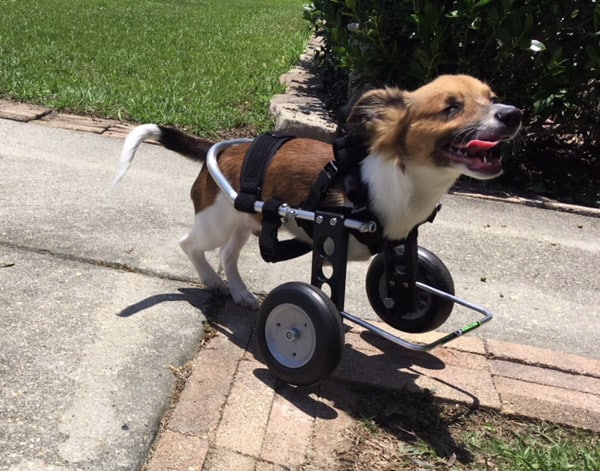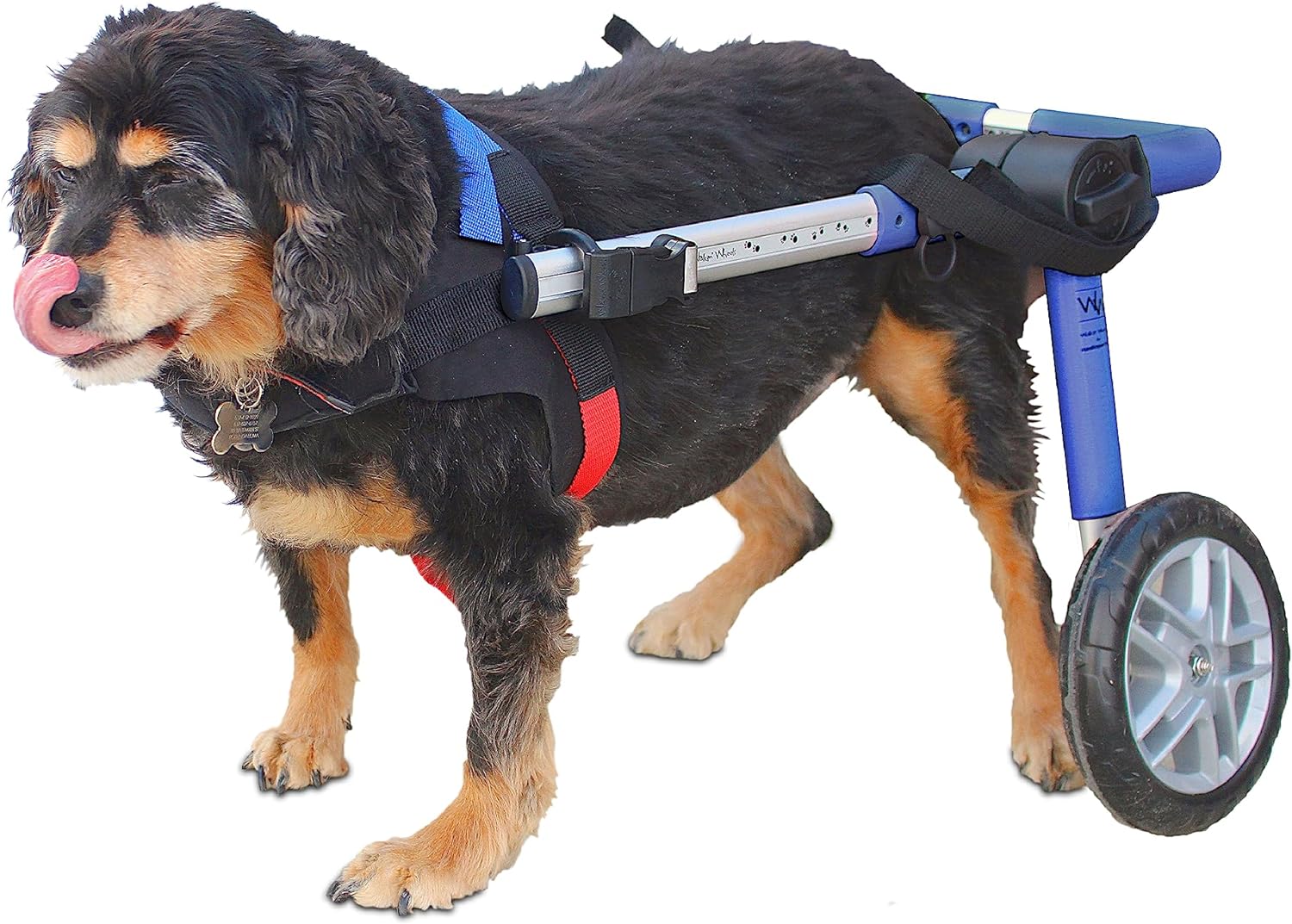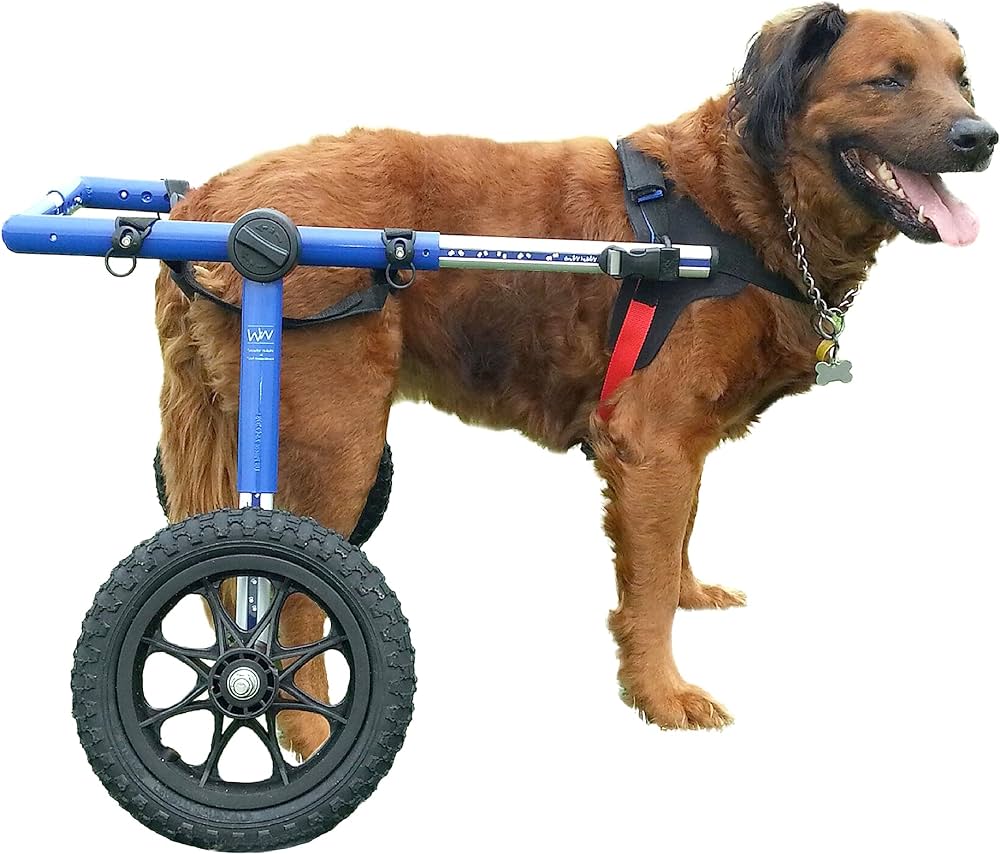Have you ever wondered if dog wheelchairs are harmful to dogs? In this article, we explore the potential impact of dog wheelchairs on our furry friends and determine whether they truly have a negative effect. Whether you’re a pet owner considering a wheelchair for your disabled dog or simply curious about the topic, read on to discover the truth behind this commonly asked question.

The Benefits of Dog Wheelchairs
Improves Mobility
Dog wheelchairs are a fantastic tool that can greatly improve the mobility of dogs with mobility issues. Whether your furry friend is experiencing hind leg weakness, paralysis, or is recovering from surgery or injury, a dog wheelchair can provide the support they need to get moving again. With the help of a wheelchair, your dog can regain the ability to go for walks, explore their environment, and engage in activities they love.
Increases Quality of Life
One of the most significant benefits of dog wheelchairs is the positive impact they can have on a dog’s overall quality of life. When a dog becomes immobile or experiences difficulty in moving, it can lead to frustration, boredom, and even feelings of depression. By using a wheelchair, dogs can regain their independence and engage in physical activities that contribute to their mental and emotional well-being. They can continue to play fetch, chase squirrels, and enjoy outdoor adventures, all of which are essential for their overall happiness.
Provides Independence
Just like us, dogs value their independence and freedom. A dog wheelchair can provide them with the opportunity to navigate their surroundings and engage in activities without constantly relying on their human companions for support. With a wheelchair, your furry friend can maintain their sense of autonomy, explore their environment, and enjoy a greater level of freedom. Not only does this benefit the dog, but it also enhances the bond between the dog and their owner, as the caregiver doesn’t have to handhold or carry the dog everywhere.
Common Concerns and Misconceptions
Fear of Dependency
One common concern regarding dog wheelchairs is the fear that the dog may become overly dependent on the device. The truth is, while dogs do rely on the wheelchair for mobility, it doesn’t make them completely dependent. The wheelchair is simply a tool that aids their movement, much like we use crutches or a walker when needed. With proper training and support, dogs can adapt to using the wheelchair without losing their independence and will continue to develop their strength and coordination.
Potential for Discomfort
Another concern that dog owners may have is the potential discomfort that a wheelchair may cause their canine companion. It’s important to understand that modern dog wheelchairs are designed with the dog’s comfort in mind. They are typically adjustable, allowing for a proper fit, with padding and support to prevent any rubbing or chafing. It’s crucial to choose a wheelchair that suits your dog’s size, weight, and specific needs to ensure maximum comfort and minimize any potential discomfort.
Physical Limitations
Some individuals worry that dog wheelchairs may limit their dog’s physical abilities or prevent them from engaging in certain activities. While it is true that wheelchairs do have physical limitations, such as difficulty navigating stairs or uneven terrain, they still offer many benefits and opportunities for dogs to be active. Wheelchairs can be used during walks, playtime, and other low-impact activities that don’t pose a risk to the dog’s safety or well-being. Additionally, depending on the type of wheelchair chosen, there may be options for rear support or full support to cater to different levels of assistance required.
Considerations for Choosing a Dog Wheelchair
Proper Fit and Adjustment
When selecting a dog wheelchair, it is crucial to ensure a proper fit and adjustment. Each dog is unique, and their specific measurements and needs should be taken into account. The wheelchair should provide enough support, without being too restrictive or uncomfortable. It’s recommended to consult with a veterinary professional or a specialist in dog mobility aids to ensure the wheelchair is appropriately sized and adjusted to accommodate your dog’s specific condition and requirements.
Material and Durability
The material and durability of a wheelchair are essential factors to consider when making your selection. A wheelchair must be sturdy enough to support your dog’s weight and withstand regular use. Look for wheelchairs made from high-quality materials, such as lightweight aluminum or stainless steel, as they provide excellent strength and durability. Additionally, choose a wheelchair that is easy to clean and maintain, as it will likely be exposed to various outdoor elements during walks and playtime.
Weight Distribution
Proper weight distribution is crucial for a dog’s comfort and balance in a wheelchair. The wheelchair should be designed to distribute the dog’s weight evenly, preventing any undue strain on their limbs or joints. This ensures that the dog maintains a natural posture and avoids the risk of further injury. Look for wheelchairs that feature adjustable straps or harnesses to secure your dog comfortably while maintaining the correct weight distribution. This will help to provide optimal support and stability, allowing your furry friend to move around with confidence.
Types of Dog Wheelchairs
Rear Support Wheelchairs
Rear support wheelchairs, also known as hind limb wheelchairs, are designed for dogs with weakness or paralysis in their hind legs. These wheelchairs offer support to the back legs of the dog, providing the necessary assistance for them to move around. Rear support wheelchairs are a popular choice for dogs with conditions such as hip dysplasia, degenerative myelopathy, or spinal injuries. They enable dogs to maintain mobility, exercise their muscles, and improve their overall strength and coordination.
Full Support Wheelchairs
Full support wheelchairs, as the name suggests, provide support for both the front and back legs of a dog. They are ideal for dogs with weakness or paralysis in all four legs or those recovering from surgery or injury. Full support wheelchairs offer the highest level of assistance and stability, allowing dogs to move around comfortably and securely. These wheelchairs are a great option for dogs with conditions such as congenital deformities, neurological disorders, or those experiencing severe muscle weakness.
Customized Wheelchairs
In some cases, dogs may require a customized wheelchair to meet their unique needs. Customized wheelchairs are designed specifically for individual dogs, taking into account their specific measurements, body structure, and condition. They are an excellent choice for dogs with complex or challenging mobility issues that cannot be adequately addressed by standard wheelchairs. Customized wheelchairs ensure a perfect fit and provide the maximum level of support and comfort for the dog’s specific condition.

Adapting to a Dog Wheelchair
Introduction and Training
Introducing a dog to a wheelchair requires patience, time, and positive reinforcement. It’s important to allow your dog to become familiar with the wheelchair gradually. Start by allowing them to explore and sniff the wheelchair in a calm environment, offering treats or praise to create positive associations. Next, slowly and gently guide your dog into the wheelchair, providing reassurance and encouragement throughout the process. Take your time and allow your dog to adjust to the sensation of wearing the wheelchair, ensuring they feel comfortable and supported. Consistency and positive reinforcement through training sessions will help your dog adapt to the wheelchair and build confidence in using it for mobility.
Monitoring and Adjustments
Once your dog is accustomed to the wheelchair, it’s crucial to monitor them closely during use. Observe their movements, body language, and overall comfort level. Check for any signs of rubbing, chafing, or redness, especially in the areas where the wheelchair comes into contact with your dog’s body. If you notice any discomfort or issues, make adjustments to the fit, padding, or straps accordingly. Regularly assess the wheelchair for any signs of wear or damage, and ensure it remains in good condition to provide optimal support and safety for your furry friend.
Physical and Mental Support
In addition to the physical support provided by a dog wheelchair, it’s essential to provide your dog with emotional and mental support during the adapting process. Offer praise and rewards for their efforts and progress in using the wheelchair. Engage in activities that your dog enjoys, such as playing with toys or spending quality time together, to maintain their mental stimulation and happiness. Stay patient and understanding, as adapting to a new device can be challenging for your dog. With your love and support, they will continue to grow more comfortable and confident in using the wheelchair.
Potential Side Effects and Risks
Skin Irritations
One potential side effect of using a dog wheelchair is the development of skin irritations. Constant contact between the wheelchair and your dog’s skin may cause rubbing or chafing, leading to redness or sores. To prevent this, it’s crucial to regularly check and adjust the wheelchair’s fit and padding. If you notice any signs of irritation, apply a pet-safe moisturizer or consult with your veterinarian for appropriate remedies or recommendations.
Muscle Atrophy
Another risk associated with prolonged use of a dog wheelchair is muscle atrophy. When a dog relies heavily on the wheelchair for mobility, their muscles may weaken due to lack of use. To combat this, it’s essential to engage your dog in regular physical therapy exercises or activities that promote muscle strength and flexibility. Consult with a veterinarian or a professional canine physical therapist for guidance on exercises and techniques that can help maintain muscle tone and prevent atrophy.
Behavioral Changes
Using a dog wheelchair can sometimes lead to behavioral changes in dogs, particularly in the initial stages of adapting. Your dog may become frustrated, anxious, or even resistant to using the device. It’s important to remain patient and understanding, providing reassurance and positive reinforcement. If behavioral issues persist or worsen, consult with a veterinarian or an animal behaviorist who can offer guidance and support to address any underlying concerns.

Consulting with a Veterinarian
Assessing the Need
Before deciding to use a dog wheelchair, it’s crucial to consult with a veterinarian to assess your dog’s specific needs. A veterinarian can conduct a thorough examination and diagnostic tests to determine the underlying cause of your dog’s mobility issues. This will help establish whether a wheelchair is the most appropriate solution or if there are other treatment options that may be more beneficial. The veterinarian’s expertise and guidance can help ensure that your dog receives the best possible care and support for their specific condition.
Professional Recommendations
Veterinarians, as well as specialists in dog mobility aids, can provide valuable recommendations when it comes to choosing the right wheelchair for your dog. They have experience working with various breeds, sizes, and mobility issues and can offer insights and expertise to help you make an informed decision. They can also guide you through the training process and provide ongoing support and advice as your dog adapts to the wheelchair. By consulting with professionals, you can ensure that your dog receives the appropriate assistance and care they need to enhance their mobility and overall well-being.
Health Monitoring
Regular check-ups with a veterinarian are essential to monitor your dog’s health and well-being while using a wheelchair. The veterinarian can assess the condition of your dog’s muscles, joints, and skin, ensuring there are no signs of discomfort, irritation, or redness caused by the wheelchair. They can make any necessary adjustments to the wheelchair fit or provide recommendations for additional treatments or therapies to maintain your dog’s overall health. By regularly monitoring your dog’s health, you can address any potential issues or concerns promptly, ensuring their continued comfort and happiness.
Real-Life Results and Testimonials
Improved Quality of Life
Many dog owners who have chosen to use a wheelchair for their furry friends have reported significant improvements in their dog’s quality of life. Dogs who were previously immobile or had limited mobility experienced a newfound sense of freedom and independence. They could resume activities they once enjoyed, such as going for walks, playing fetch, or exploring their surroundings. Owners have noticed a renewed zest and happiness in their dogs, which has greatly enhanced the well-being and overall life satisfaction of both the dog and their human companions.
Regained Mobility
One of the most remarkable benefits of using a dog wheelchair is the ability for dogs to regain their mobility. For dogs suffering from conditions such as degenerative disc disease, spinal cord injuries, or arthritis, wheelchairs have provided a lifeline, allowing them to move freely and without pain. With regular use and proper support from the wheelchair, dogs have shown improvements in their strength, coordination, and overall mobility. Many dogs who were once confined to a sedentary lifestyle have been able to enjoy an active and fulfilling life once again.
Happy and Active Dogs
Perhaps the most heartwarming result of using a dog wheelchair is the restoration of joy and happiness in the dogs themselves. Wheelchairs have enabled dogs to stay active, engaged, and social, contributing to their emotional and mental well-being. Dogs have been able to continue playing with their favorite toys, interacting with other dogs, and enjoying outdoor adventures. This increased activity and stimulation have not only improved their physical fitness but have also alleviated feelings of isolation or frustration that can occur when mobility is limited. Overall, the use of a wheelchair has led to happier and more satisfied dogs.

Alternative Mobility Aids for Dogs
Orthopedic Devices
In addition to dog wheelchairs, there are several alternative mobility aids available for dogs with mobility issues. Orthopedic devices, such as braces or splints, can provide targeted support for specific areas of the body, such as joints or limbs. These devices can help stabilize weak or injured areas, reduce pain, and promote proper healing. Orthopedic devices are often used in conjunction with a wheelchair or as a standalone option, depending on the individual dog’s needs and condition.
Physical Therapy
Physical therapy can be a beneficial treatment option for dogs with mobility issues. Just like humans, dogs can benefit from exercises and techniques that improve their strength, flexibility, and range of motion. A professional canine physical therapist can assess your dog’s condition and develop a tailored program to target specific areas of weakness or limitation. Physical therapy can help dogs regain mobility, improve muscle tone, and support their overall well-being.
Assistive Harnesses
Assistive harnesses are another alternative mobility aid for dogs. These harnesses are designed to provide additional support and stability to dogs with mobility issues. They can be used for dogs with hind leg weakness or those recovering from surgery. Assistive harnesses are effective in helping dogs maintain balance, preventing falls, and supporting their overall mobility. These harnesses can be a practical option for dogs who may not require the full assistance of a wheelchair but still need some extra support to move around comfortably.
Conclusion
When it comes to the well-being and mobility of our beloved canine companions, dog wheelchairs offer numerous benefits. They improve mobility, increase quality of life, and provide dogs with the independence and freedom they deserve. While there may be concerns and misconceptions surrounding their use, proper fit, adjustment, and support can address and alleviate any potential issues. Consulting with a veterinarian and professionals in dog mobility aids is crucial to ensure the right wheelchair is chosen and that the dog receives appropriate care throughout the process. With the use of a wheelchair, dogs can experience improved quality of life, regain lost mobility, and remain happy and active companions. By considering individual needs, focusing on canine comfort, and enhancing their overall well-being, dog wheelchairs can make a positive difference in the lives of both dogs and their human companions. So, embrace the benefits of dog wheelchairs and give your furry friend the gift of mobility and freedom they truly deserve.



